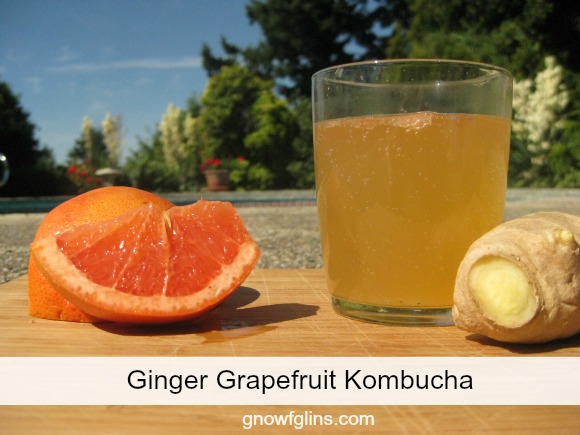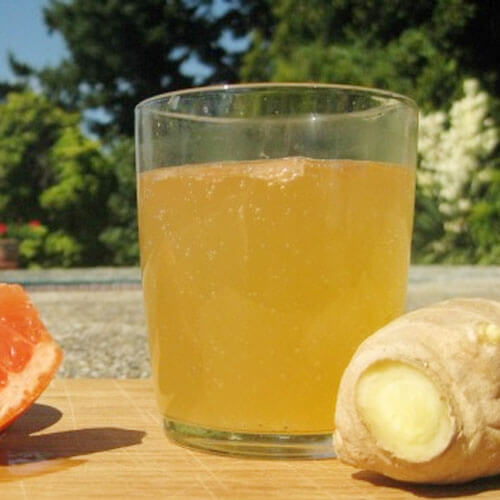
On hot days, nothing satisfies thirst like a cold, bubbly beverage. This Ginger Grapefruit Kombucha just so happens to fit the bill perfectly. It’s light, citrus-y, and refreshing. And of course nourishing and probiotic — because it’s kombucha.
What Is Kombucha?
Kombucha is a fermented, probiotic beverage that has been brewed for thousands of years. In ancient Mongolia, it was the drink of warriors who believed it gave them strength and vitality. In ancient China and up until the more modern Chinese Cultural Revolution, it was brewed as an elixir of longevity. And as it traveled the Silk Road into Russia and Eastern Europe, there are even stories that the elderly women who had consumed kombucha regularly throughout their lives showed significantly less radiation damage in the Chernobyl nuclear fallout.
Whether these legends are true or just grand stories of lore, suffice it to say, kombucha has been brewed throughout history as a cleansing tonic and boon of good health.
In my house, we brew it just because we like it. 🙂 Our toddler and preschooler can’t get enough of it and my husband likes it to pack it along in his work lunch — if I can keep it in stock.
Interested in fermenting more of your own foods? While you’re here, be sure to grab our free fermenting formulas cheat sheet that will give you proportions and ingredients for all kinds of ferments — from salsas and relishes to krauts, jams, and beverages. Grab it here.
What Can You Do With Kombucha?
Kombucha is incredibly versatile. Plain kombucha is a fabulous blank canvas, especially in summertime, to add your own favorite flavors via a second (and optional) ferment. Perhaps try Chai Kombucha or use it as a mixer in a kombucha cocktail. The ginger-grapefuit blend (recipe below) is one of our favorite ways to dress up our Kombucha with an additional fermentation.
You can use Kombucha outside drinks, too. Say in kombucha jello or as the base for a lovely fresh vinaigrette. And if you want to go really wild, you can even turn your extra SCOBYs (recommended source)– the Kombucha mother culture — into kombucha scoby jerky (taught in our Dehydrating eCourse).
If you want to be oh-so-seasonal with your drink, you can also just stir basic Kombucha together with juice squeezed from this season’s abundant fresh berries. Yum!
However you chose to use it, be sure to try this Ginger Grapefruit Kombucha as well. It won’t disappoint!

Ginger Grapefruit Kombucha
On hot days, nothing satisfies thirst like a cold, bubbly beverage. This Ginger Grapefruit Kombucha just so happens to fit the bill perfectly. It's light, citrus-y, and refreshing. And of course nourishing and probiotic — because it's kombucha.
Makes about 1 quart.
Ingredients
- 3 cups kombucha plain*
- 1 inch fresh ginger cut into matchsticks
- 1/2 to 1 cup Ruby Red grapefruit juice juice from 2 grapefruit
Instructions
-
In a clean 1-quart mason jar or Grolsch-style flip top bottle, mix the kombucha, ginger, and grapefruit juice, leaving at least 1" of headspace.
-
Cover tightly with the lid and set aside at room temperature (68 to 72 degrees Fahrenheit is ideal) for 1 to 2 days.
-
Move to the refrigerator until well chilled.
-
When ready to drink, open carefully, as kombucha sometimes bubbles fiercely and sometimes not!
-
Serve cold.
Recipe Notes
*Learn how to brew kombucha here or here.
If you would prefer not to juice your grapefruits, you can scrub them well, then cut them in small pieces and merely place the pieces in the bottle or jar along with the ginger, then pour the kombucha over.
I find this gives a stronger grapefruit flavor, but also leaves a much more bitter aftertaste, so use your discretion and brew to taste!
Have you ever brewed kombucha? What’s your favorite flavor for the second fermentation?
Interested in fermenting more of your own foods? While you’re here, be sure to grab our free fermenting formulas cheat sheet that will give you proportions and ingredients for all kinds of ferments — from salsas and relishes to krauts, jams, and beverages. Grab it here.
This post featured in 60 Easy & Nourishing Picnic Recipes.
...without giving up the foods you love or spending all day in the kitchen!

2 free books:
Eat God's Way
Ditch the Standard American Diet, get healthier & happier, and save money on groceries...
We only recommend products and services we wholeheartedly endorse. This post may contain special links through which we earn a small commission if you make a purchase (though your price is the same).


Love it! I’ve been drinking kombucha for about about 5 mo. now, plain with no flavoring. I’ve been hoping to find a way to change it up and this looks perfect!
Jenny,
That’s fabulous. Enjoy! 🙂
Update: I tried the recipe and it is just as good as I thought it would be. And a bonus was that it turned out really fizzy, which I love!
Ginger is my absolute favorite flavoring in kombucha, but I always juice it in my juicer. I feel like it “fixes” the flavor if I let it go a little too long :). I can’t wait to try with grapefruit.
Oh, that’s a great idea! I’ve got to try that! 🙂
I’ve been brewing my own (continuous brew) for a year now and I always 2nd ferment! The more comfortable I became making it – the longer I let it brew. Because usually I just forget about it till I start smelling it as I walk by! My favorite so far were the batches I made last winter from the pink grapefruit directly from Naples, FL. I used to live there and knew where to order to get the best!!
Also I like lemon (especially Meyer) and orange. Just the other day I found organic pomegrante juice really cheap so that my latest batch flavor. And I always add stevia along with the little bit of sugar for the 2nd ferment. Because I like mine sweet. Have also used frozen grape juice – not my favorite (too sweet!) but still good. And if I have some leftover after filling all my prepared bottles, I use it for smoothies or for soaking beans or grains.
Thanks for all those great ideas. I’m getting thirsty just reading them!
Thanks for sharing the smoothie and soaking tips too! 🙂
What does it mean to “second brew”? I started brewing plain Kombucha for a while and I was so proud of myself:) Then we put our farm on the market and I could no longer leave it out on the counter. Sooo, when we sell and settle in our new home I want to try it again. I would love to hear from people who make it regularly because I was not terribly confident in my brew.
“Second brew” merely refers to the flavoring stage of the kombucha, which is optional.
The first stage turns your sweet tea into kombucha – that stage is usually 10-30 days. At the end you have finished but unflavored kombucha, which you can certainly drink plain – or you can choose to flavor it.
This is the “second brew,” where you take plain kombucha and add whatever flavorings you want and let it sit for another 1-2 days with the flavorings, during which it continues to ferment, which makes it bubbly and effervescent, like a sparkling soda. (Just keep in mind that some secondary ferments produce prodigious bubbles and some only a few. Both are fine – they’re just different.)
So, either way is fine and you can feel confident you’re doing it right. 😉
I hope your farm sells soon and you can settle in your new home quickly!
My second brew sits until I bottle my next batch – has been as long as 3 weeks before refrigerating it. Because I just forget about it. I put my bottles (either “old” purchased kombucha bottles or wine bottles) in the wine grocery bags for protection and then into a cooler in the closet. So if they explode, Voila! Everything is contained in the cooler. Never had one explode. I used to use corks on the wine bottles and those would pop off but now I have the screw top bottles and use them instead.
People use different containers – I prefer the big brewer with a spigot – it was initially expensive but so worth it for me. I can just bottle and fill and leave it alone – think I’ve only cleaned it out twice last year and it was still clean and no problem. I usually separate the scoby every 3-4 months – it gets huge inside the big brewer.
Just on a little roll here – I usually add hibiscus to my tea and it turns the kombucha a lovely pink color – sometimes I add other herbs to the black (assam or oolong) and green (yerba mate) teas. My favorites are tulsi and linden – have never added any mint but mmmm…may try that.
Some recommend against using herbs with high oil contents as they may damage the scoby – I know a lady who uses whatever she wants including commercial tea blends with high oil blends and she’s never had a problem. After you get comfortable with the whole brewing process you’ll feel a lot more confident in trying different things.
Pamela – just do it – you’ll become so much more comfortable – I’m the last person you’d expect that would be giving others tips on brewing kombucha! Hehehehehe……..My friend had to “strongly” encourage me to try it – I didn’t even consider it until I started buying it and it turned into a very expensive “habit”. Now, even when using the most expensive flavorings (like Florida grapefruit shipped directly from the source!) it’s still soooo…..much cheaper than buying it. And so much more delicious.
NancyLee,
Out of curiosity, you mention not using herbs that may damage the scoby. Do you do your second ferment in the same jar as your primary ferment, scoby and all? Or do you tend to add the herbs to your individual jars and pour in the plain kombucha? Just curious!
Hi Kresha – when I first started brewing my own kombucha I read that teas with a lot of essential oils should not be used (like Earl Grey, mints, and other flavored teas) to make the sweet tea for brewing. I just thought of it when I was writing the post because I thought of using mint in my next batch. I have two small muslin bags. One bag holds a few tbsps of yerba mate and a black tea. The other bag I put herbs in – the hibiscus, holy basil, or linden or lemon verbena. Those are the ones that come to mind. I just add both those bags to the simmering sugar water and make up the sweet tea.
After brewing a week or two or three (or four!), I then bottle all but what is below the spigot – that is the starter tea for the next batch. I put a ounce (or so or more!) of flavoring (including more sugar to make carbonation and stevia for sweetness) in the bottom of the 16 oz bottles and 2 or more ounces in the bottom of the wine bottles (I have a 2 1/2 gallon brewer). Then just fill the bottles Seems like I usually get about 10 regular bottles and 3-4 wine bottles per batch. I like the individual 16 oz bottles to take to work and use the kombucha in the wine bottles at home.
(Guess the wine bottles wouldn’t go over so well at work! I work in labor and delivery. The other day we were so busy I didn’t get to drink or eat anything till late in the afternoon – gobbled up some baked potato and the bottle of kombucha. When my patient asked my if I’d gotten anything to eat I told her I was happy – I had my kombucha. The family asked what it was – I said a fermented drink and they all laughed. “No wonder you’re so happy!” It was funny!)
I made peach raspberry fruit cubes and store in the freezer. When I have a bottle of kombucha ready, I toss a few cubes in for a second fermentation…yum!
Oh, that’s sounds yummy! And how convenient. 😉
I like to put a splash of organic juice into my kombucha and add chia seeds. Grape and pineapple are my favorites. When adding chia seeds, stir them into your kombucha with a fork for about a minute to avoid clumping. We LOVE the texture and interest that the chia seeds give to the kombucha.
Oh, that sounds yummy! Thanks for the idea. 🙂
My favourite right now is peaches and cloves. I try to flavour with in season fruit, then switch to de-hydrated fruits in winter.
What a great way to consume fermented foods AND seasonal produce. 🙂 I’ll have to try that this winter. Do you have any favorites for dehydrating?
I just joined Weight Watchers almost at the same time my friend gave me a scooby to try. But I am not sure how to calculate WW points for this. Does the sugar from the first ferment get absorbed into the scooby? Anybody know? I am just now today ready to drink it, but do not want to drink a bunch of calories. =(
TIA!
12oz is 2 pts
When I buy flavored kombucha from the store, it’s labeled as 35 calories per 8 oz. I hope that helps a bit.
my faves are green tea and ginger tea brewed together and white tea with lemon zinger. mostly, i drink my kombucha in a smoothie.
I have been double brewing for almost a year. Mostly I stuck to orange peel, lemon peel, candied dried ginger and a bit of fresh ginger. The kids loved it so I figured, why change it, until…we discovered (2 pieces cut small) dried pineapple (for sugar ), (2 pieces cut up small) frozen pineapple and 4 drops of coconut flavoring!. I add this combo to one litre brewed plain Kombucha.
We’ve experimented with 1 Tbsp. Raspberry jam and a few frozen raspberries with good results, too. Mashing frozen fruit seems to encourage it to let go of its juice. (Once we added a drop of vanilla to the raspberry Kombucha but the kids said to skip it next time.)
I have been making a kale (2 Cups) & fruit smoothie (combination of peaches, mangoes, pineapple, strawberries about 1 cup) and where the recipe called for 1 Cup of water, I put in 8 oz of ginger kombucha and it’s just delicious!!
Our favorite second ferments are blueberry (just put a couple spoonfuls of fresh or frozen blueberries in the bottle or jar, then fill with booch) and strawberry lime!
It’s fun to read other ideas about second fermenting and brewing kombucha! Thanks for all the ideas.
I use 1/2 darjeeling and 1/2 oolong for my sweet tea, and some of my favorite flavors for second fermenting are
-raw almonds (4-6 per 24 ounce bottle), dried cherries (4-6), and about 1/4 a vanilla bean.
-dried elderberries (about 1 Tbsp) and a small piece of clove (it’s very strong)…I tried a piece of star anise, but it is really strong and I didn’t like it as well.
-goji berries and almonds.
-organic blueberry juice (2 ounces), it has a lovely floral taste.
-grapefruit segments without any rind or membrane.
-raisins and walnuts.
I can’t wait to try hibiscus! I have some that for some reason haven’t opened yet.
Thanks for all the other ideas!
Virginia
Oh, my what fantastic ideas for flavorings! I have a question about the fruit in the kombucha. I read somewhere you need to strain out the fruit after 24 hours. Are any of you straining, or just leaving it in?
Thank you for the wonderful tips and ideas.
I tried this with about a 1/2 C grapefruit juice in my resealable brewing bottles that hold about 2 C Kombucha each, added some chopped ginger and 2nd fermented for about 4 days. A little sweeter than I like, might drop to 1/4C juice next time, but love the ginger kick combo!